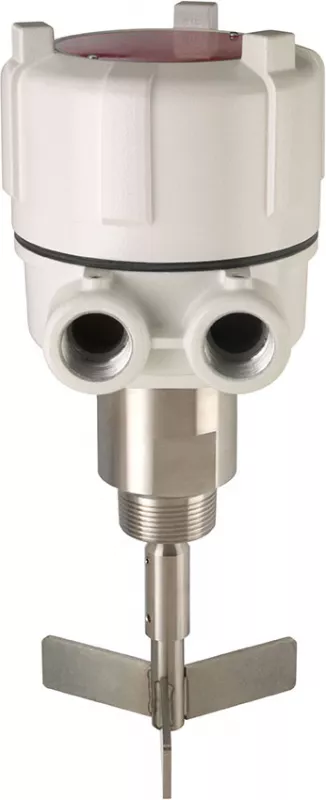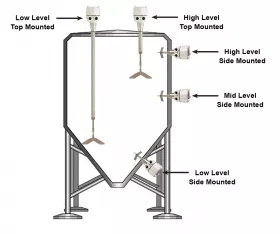Inventory management is all about inventory and controlling its related costs. Your job is to figure out just how much material you have on hand and the right time to bring in more. But your inventory is most likely stored in a large, dark, and often dusty vessel. Short of x-ray vision, youhave no way to safely “see” what is actually in them.
Fortunately, there are many devices available to help you accurately measure your inventory. One category of inventory monitoring technology is called point level. Point level indicators are an affordable stand-alone tool that acts as alert when inventory has reached a high or low level or as a level alarm when used as part of an inventory management system. Easy to set up and configurable to fit yourapplication’s needs, point level indicators are a must have for a safe, efficient operation.
Let’s explore some point level sensor options and considerations when selecting a device.
Rotary Level Indicators
Rotaries are a familiar and common device used for high or low-level point level indication in bins, tanks, and silos. Rotaries are versatile enough to use in nearly any material from powders and granules with a minimum bulk density of 2 lb/ft3 (approx. 32 kg/m3) to coarse, lump materials with bulk densities up to 150 lb/ft3 (approx. 2400 kg/m3).
The principle of operation for rotaries is quite simple. When the rotary is used to alert that material has reached a high level while the tank is filling, the paddle rotates continually until material reaches the paddle. When the paddle meets resistance due to the presence of material, it stops rotating and sends an alert via a control room, horn, light, or an alarm panel. Conversely, as a low-level indicator, the paddle will begin turning when material drops below the level of the paddle and will send an alert or can be wired to shut off a process system.
There are different types of rotaries that warrant consideration depending on how critical the role of the rotary is in the operation. Most standard rotaries are designed to provide protection from system power failure. Some feature a motor that “goes to sleep” or “de-energizes” to automatically shut down when material is present, which also serves to extend motor life. If the rotary is critical in starting, stopping, or controlling a process, or causing a work stoppage if a tank should become empty, the application calls for a fail-safe rotary. These rotaries continually self-diagnose, and in the event of a failure, send an immediate warning and instantaneous corrective response. Fail-safe models often have an LED light or other visual indicator on the unit for visual monitoring of the motor status.
Rotaries are increasingly applied in new and innovative ways. For high level detection at the interior of a vessel, a vertical extension on a rotary can allow it to be extended as far as 12 ft (approx. 3.65 m) down into the bin, tank, or silo. This configuration is recommended for a center-fill vessel when the operation requires a specific amount of headroom. Mounted on the top of the vessel, a vertically-extended rotary can alert when material is higher toward the center of the container, versus simply detecting the level of material near the sidewall which could be at a lower level when filling (cone up) and at a higher level when emptying (cone down). For thick tank walls, such as those in cement silos, a horizontal extension allows for a rotary to be used to detect material levels through the sidewall. When a horizontal extension is combined with a collapsible paddle, the rotary can be installed through a 1-1/4″ or 1-1/2″ NPT opening without entering the vessel.









